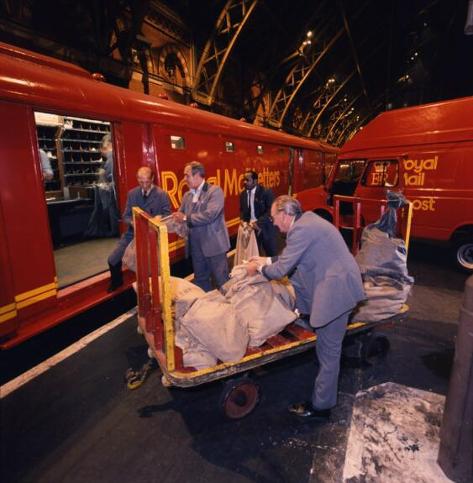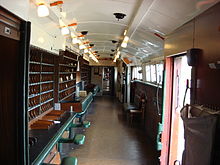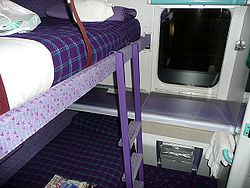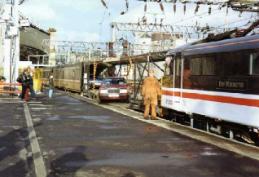Changing times since BR
Since British Railways were privatised many changes have happened and the future railways are being planned and built even now leaving British Rail just a memory long ago. The older Drivers from British Rail days now work in a new world and for new companies, they may drive over the same routes but with newer modern trains that near enough drive themselves.
In the 1980's British Rail tried a few advertising campaigns to get people on to their trains and used slogans as "We're Getting There" and "This is the age of the train" , advertising the Intercity 125 and the supersaver ticket. Oh how the commuters wished back then that the railways were privatised with hopes of clean, new trains running on time and even of being able to travel seated. Now they cry for them to be nationalised as the new trains dont come up to their expectations and passengers still arrive late on over crowded trains. When watching old films you see restaurants cars with dressed up passengers eating real food compared to todays airline style food slapped on a drop down lap tray.
The Travelling Post Office

The Travelling Post Office (TPO) was a mail train in the UK where the post was sorted en route on overnight trains running the length of the country. The carriages had a First Class Post Box built into the exterior. The last Travelling Post Office services were ended on 9 January 2004, with the carriages used now sold for scrap or to preservation societies. This service had been running since the 1830's.

above: inside the TPO
left: loading mail onto the TPO to be sorted en-route
The Sleeper and Motorail
In the United Kingdom, a network of trains with sleeping cars operates daily between London Euston and Scotland (Caledonian Sleeper).
The Highland Sleeper goes to Aberdeen/Inverness/Fort William.
The Lowland sleeper goes to Glasgow/Edinburgh.
A service also operates between London Paddington and the West Country as far as Penzance, Cornwall (Night Riviera). Using rolling stock designed and formerly operated by British Rail, these services offer a choice of single- or double-occupancy bedrooms. There is also a steward/stewardess to call for assistance through out the night and a courtesy wake up call with a cup of tea or coffee.


When British Rail ran the services you could also take your car with you which was driven into a covered wagon and attached to the train and called Motorail. This service was withdrawn in 2005.
The Dining Car
Surely it’s one of the last civilised experiences left in the modern world of travel. The soothing clink of cutlery on china, the starched tablecloths, a smartly uniformed steward at your elbow serving dinner in the restaurant car as the scenery of our green and pleasant land flashes past the window. For more than a century, the time- honoured words ‘Last call for the dining car’ have summoned hungry passengers for lunch or dinner on trains across the land. But that all ended in 2011.
At the end of the British Rail era just 17 years ago there were 249 restaurant car services across Britain. Now, it is especially ironic that the death-blow for the dining cars has been delivered not by some profit-hungry franchise, but by the nationalised train company formed to operate the main line to Edinburgh after its previous operator collapsed. On privatisation in 1994, the Government decreed that no more than 80 restaurant cars should run on this line. Now the management at the Department for Transport are in charge, they have decided there should be none. Instead of restaurants, open to anyone on the train, the East Coast company that operates services out of King’s Cross now plans airline-style meals to be served at the seats of first-class passengers only, while standard-class travellers will be condemned to microwaved burgers from the buffet car.

Lunch aboard the train in Victorian times would have been a five-course affair, with staples such as grilled turbot, roast sirloin, salmon with hollandaise sauce, bread-and-butter pudding, apple tart and crème caramel. The cost in 1898 was half a crown - about £10 in today’s money and considerably cheaper than the £35 price of dinner on tomorrow’s final service.The early waiters learned their trade in special sealed-off dining cars where they were trained to walk along a white line wearing a blindfold while the train moved at speed. Each route around the country had its own culinary specialities. On the Metropolitan Railway (now the Metropolitan Line of the Tube), commuting stockbrokers could have both breakfast and dinner aboard a special Pullman car to and from the London suburbs. The old Great Eastern Railway, which was the first to provide restaurant cars for third-class passengers, ran evening restaurant cars to almost every minor town in East Anglia, including midnight 'supper trains' to Essex seaside resorts. Most famous of all was the Brighton line, renowned for its grilled kippers — much loved by the actor Lord Olivier, who campaigned to save them when British Rail tried to drop them from the menu. In the last days of the Brighton Belle at the end of the 1960s, a kipper for breakfast cost the equivalent of just 11p and grilled steak, chips and peas for lunch a mere 95p. All served amid the magnificent art deco marquetry of 1920s carriages with lovely names such as Audrey and Vera.
Most of all, though, East Coast wants to get more people to pay a premium fare by offering free meals at every first-class seat. ‘It’s about providing better value with the first-class ticket,’ says a spokesman. The problem for today’s train travellers is that ‘better value’ is often corporate railwayspeak for ‘worse service’. I frequently wonder if deep in railway operations HQ there is a department whose sole job it is to think up ideas to diminish the experience of passengers — seats that don’t line up with the window, an incomprehensible fares system, ticket collectors who assume everyone is a criminal — and of course, the abolition of restaurant cars.
The experience as a traveller on the rival Virgin West Coast Main Line, which has long abandoned restaurant cars for airline-style food, does not hold out much hope for East Coast travellers pining for the loss of their dining cars. A ‘first class’ lunch on a Glasgow-London train consisted of an egg-and-cress sandwich and a banana. No fine china or glassware - just a mug or the sort you might find in a transport caff and a plastic place mat. No wonder they offer as much free booze as you can drink. This is presumably to get you to forget the awfulness of the food. But even this is better than some train operators, where a first-class ticket entitles you to not much more than a cup of tea and a packet of biscuits if you are lucky.
It’s a far cry from even quite recent times when entire trains, such as the Yorkshire Pullman and the Cambridge Buffet Express, had names dedicated to the idea of eating and drinking on board. And there was a reasonable expectation that one might find a restaurant on even modest services. I have delicious memories of a supper of smoked haddock and poached egg aboard a Mallaig to Glasgow train, watching the sun set over the Isle of Skye. The decline should not have to be inevitable. Transport analyst Barry Doe, who has long campaigned against the closure of the restaurant cars, says: ‘The trouble is that the accountants who run the railways see trains merely as aeroplanes without wings. What they fail to spot is the marketing opportunity of a dining experience that we British regard as very special.
‘On long train journeys, operators have a captive audience and much as they seem not to believe it, passengers do eat. Shame on them for not understanding this!’